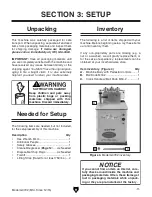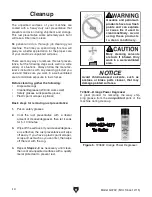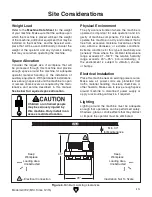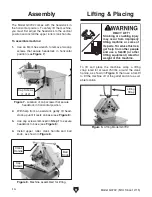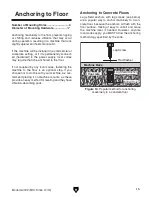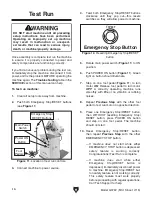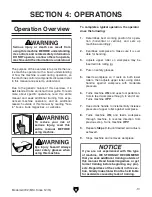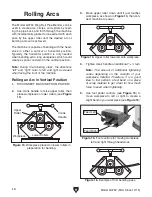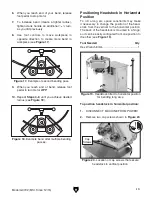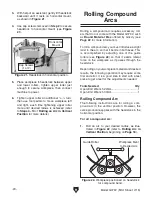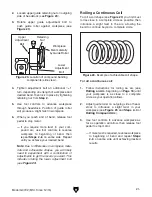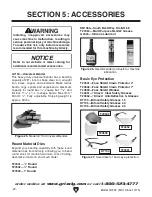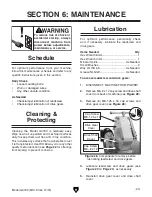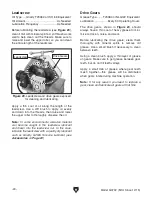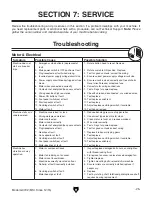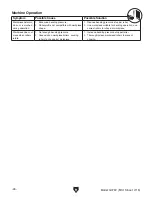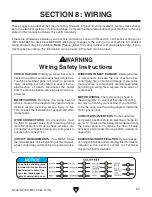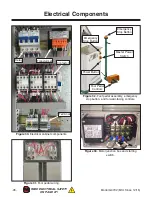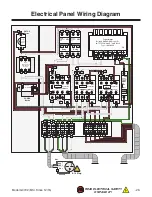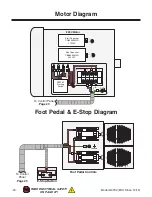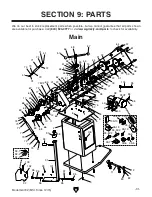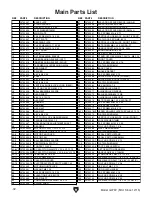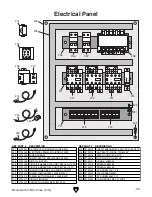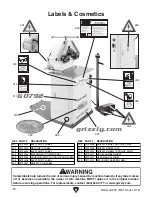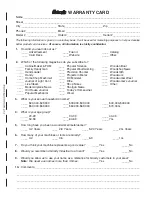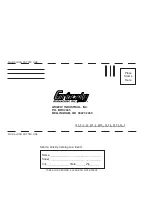
Model G0792 (Mfd. Since 12/15)
-25-
Review the troubleshooting and procedures in this section if a problem develops with your machine. If
you need replacement parts or additional help with a procedure, call our Technical Support.
Note: Please
gather the serial number and manufacture date of your machine before calling.
SECTION 7: SERVICE
Troubleshooting
Motor & Electrical
Symptom
Possible Cause
Possible Solution
Machine does not
start or a breaker
trips.
1. Emergency stop button(s) depressed/at
fault.
2. Main power switch in OFF position/at fault.
3. Plug/receptacle at fault/wired wrong.
4. Incorrect power supply voltage/circuit size.
5. Power supply circuit breaker tripped or fuse
blown.
6. Motor wires connected incorrectly.
7. Contactor not energized/has poor contacts.
8. Wiring open/has high resistance.
9. Power ON button at fault.
10. Foot pedal switch(es) at fault.
11. Start capacitor at fault.
12. Centrifugal switch at fault.
13. Motor at fault.
1. Rotate button head to reset. Replace.
2. Rotate switch to ON position. Replace.
3. Test for good contacts; correct the wiring.
4. Ensure correct power supply voltage/circuit size.
5. Ensure circuit is sized correctly and free of shorts.
Reset circuit breaker or replace fuse.
6. Correct motor wiring connections.
7. Test all legs for power/replace.
8. Check/fix broken, disconnected, or corroded wires.
9. Test/replace.
10. Test/replace switch(es).
11. Test/replace.
12. Adjust/replace centrifugal switch if available.
13. Test/repair/replace.
Machine stalls or is
underpowered.
1. Machine undersized for task.
2. Wrong workpiece material.
3. Motor overheated.
4. Motor wired incorrectly.
5. Contactor not energized/has poor contacts.
6. Plug/receptacle at fault.
7. Gearbox at fault.
8. Run capacitor at fault.
9. Centrifugal switch at fault.
10. Foot pedal switch(es) at fault.
11. Motor bearings at fault.
1. Reduce bending pressure of upper roller.
2. Use correct type/size of metal stock.
3. Clean motor, let cool, and reduce workload.
4. Wire motor correctly.
5. Test all legs for power/replace.
6. Test for good contacts/correct wiring.
7. Replace broken or slipping gears.
8. Test/replace.
9. Adjust/replace centrifugal switch if available.
10. Test/replace switch(es).
11. Test/replace.
Machine has
vibration or noisy
operation.
1. Motor or component loose.
2. Motor fan rubbing on fan cover.
3. Motor mount loose/broken.
4. Machine incorrectly mounted on floor.
5. Roller(s) at fault/incorrectly installed.
6. Centrifugal switch at fault.
7. Motor bearings at fault.
1. Inspect/replace damaged bolts/nuts, and retighten
with thread-locking fluid.
2. Fix/replace fan cover; replace loose/damaged fan.
3. Tighten/replace.
4. Tighten mounting bolts; relocate/shim machine.
5. Ensure rollers are correctly installed, replace if
necessary.
6. Replace.
7. Test by rotating shaft; rotational grinding/loose shaft
requires bearing replacement.
Summary of Contents for G0792
Page 44: ......

